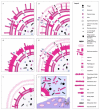Potential for Phages in the Treatment of Bacterial Sexually Transmitted Infections
- PMID: 34572612
- PMCID: PMC8466579
- DOI: 10.3390/antibiotics10091030
Potential for Phages in the Treatment of Bacterial Sexually Transmitted Infections
Abstract
Bacterial sexually transmitted infections (BSTIs) are becoming increasingly significant with the approach of a post-antibiotic era. While treatment options dwindle, the transmission of many notable BSTIs, including Neisseria gonorrhoeae, Chlamydia trachomatis, and Treponema pallidum, continues to increase. Bacteriophage therapy has been utilized in Poland, Russia and Georgia in the treatment of bacterial illnesses, but not in the treatment of bacterial sexually transmitted infections. With the ever-increasing likelihood of antibiotic resistance prevailing and the continuous transmission of BSTIs, alternative treatments must be explored. This paper discusses the potentiality and practicality of phage therapy to treat BSTIs, including Neisseria gonorrhoeae, Chlamydia trachomatis, Treponema pallidum, Streptococcus agalactiae, Haemophilus ducreyi, Calymmatobacterium granulomatis, Mycoplasma genitalium, Ureaplasma parvum, Ureaplasma urealyticum, Shigella flexneri and Shigella sonnei. The challenges associated with the potential for phage in treatments vary for each bacterial sexually transmitted infection. Phage availability, bacterial structure and bacterial growth may impact the potential success of future phage treatments. Additional research is needed before BSTIs can be successfully clinically treated with phage therapy or phage-derived enzymes.
Keywords: antibiotic resistance; bacteriophage; endolysins; phage therapy; sexually transmitted infections.
Conflict of interest statement
R.M., B.W.-D. and A.G. are co-inventors of patents owned by the Hirszfeld Institute of Immunology and Experimental Therapy covering phage preparations. K.C., V.M., S.L., M.Ł.-S. and J.R. declare that they have no conflict of interest.
Figures

Similar articles
-
Presence of Chlamydia trachomatis and Mycoplasma spp., but not Neisseria gonorrhoeae and Treponema pallidum, in women undergoing an infertility evaluation: high prevalence of tetracycline resistance gene tet(M).AMB Express. 2017 Nov 17;7(1):206. doi: 10.1186/s13568-017-0510-2. AMB Express. 2017. PMID: 29150724 Free PMC article.
-
In vitro activity of lomefloxacin against Chlamydia trachomatis, Neisseria gonorrhoeae, Haemophilus ducreyi, Mycoplasma hominis, and Ureaplasma urealyticum.Diagn Microbiol Infect Dis. 1989 May-Jun;12(3 Suppl):83S-86S. doi: 10.1016/0732-8893(89)90071-0. Diagn Microbiol Infect Dis. 1989. PMID: 2507222
-
Prevalence of Chlamydia trachomatis, Neisseria gonorrhoeae, Mycoplasma genitalium and Ureaplasma urealyticum infections using a novel isothermal simultaneous RNA amplification testing method in infertile males.Ann Clin Microbiol Antimicrob. 2017 Jun 24;16(1):45. doi: 10.1186/s12941-017-0220-2. Ann Clin Microbiol Antimicrob. 2017. PMID: 28646898 Free PMC article.
-
[Up to date in sexually transmitted infections: epidemiology, diagnostic approaches and treatments].Enferm Infecc Microbiol Clin. 2004 Aug-Sep;22(7):392-411. doi: 10.1016/s0213-005x(04)73123-7. Enferm Infecc Microbiol Clin. 2004. PMID: 15355770 Review. Spanish.
-
The role of fluoroquinolones in sexually transmitted diseases.Pharmacotherapy. 1993 May-Jun;13(3):189-201. Pharmacotherapy. 1993. PMID: 8321733 Review.
Cited by
-
Alternatives Therapeutic Approaches to Conventional Antibiotics: Advantages, Limitations and Potential Application in Medicine.Antibiotics (Basel). 2022 Dec 16;11(12):1826. doi: 10.3390/antibiotics11121826. Antibiotics (Basel). 2022. PMID: 36551487 Free PMC article. Review.
-
Phage-based biocontrol of Porphyromonas gingivalis through indirect targeting.Appl Environ Microbiol. 2024 Oct 23;90(10):e0095124. doi: 10.1128/aem.00951-24. Epub 2024 Sep 9. Appl Environ Microbiol. 2024. PMID: 39248462 Free PMC article.
-
Chlamydial and Gonococcal Genital Infections: A Narrative Review.J Pers Med. 2023 Jul 21;13(7):1170. doi: 10.3390/jpm13071170. J Pers Med. 2023. PMID: 37511783 Free PMC article. Review.
-
Current alternative therapies for treating drug-resistant Neisseria gonorrhoeae causing ophthalmia neonatorum.Future Microbiol. 2024;19(7):631-647. doi: 10.2217/fmb-2023-0251. Epub 2024 Mar 21. Future Microbiol. 2024. PMID: 38512111 Free PMC article. Review.
-
Prediction of Prophages and Their Host Ranges in Pathogenic and Commensal Neisseria Species.mSystems. 2022 Jun 28;7(3):e0008322. doi: 10.1128/msystems.00083-22. Epub 2022 Apr 14. mSystems. 2022. PMID: 35418239 Free PMC article.
References
-
- O’Neill J. Tackling Drug-Resistant Infections Globally: Final Report and Recommendations the Review on Antimicrobial Resistance. 2016. [(accessed on 4 July 2021)]. Available online: https://amr-review.org/sites/default/files/160518_Finalpaper_withcover.pdf.
-
- Centers for Disease Control and Prevention New CDC Analysis Shows Steep and Sustained Increases in Stds in Recent Years. [(accessed on 10 June 2019)];2018 Available online: https://www.cdc.gov/nchhstp/newsroom/2018/press-release-2018-std-prevent....
-
- Centers for Disease Control and Prevention Antibiotic Resistance Threats in the United States. [(accessed on 10 June 2019)];2013 Available online: https://www.cdc.gov/drugresistance/threat-report-2013/pdf/ar-threats-201....
Publication types
Grants and funding
LinkOut - more resources
Full Text Sources

